7 B2B marketing mistakes that can hurt your growth in 2023
written by
Elena Iordache
date
16 January 2023
written by
Elena Iordache
date
16 January 2023
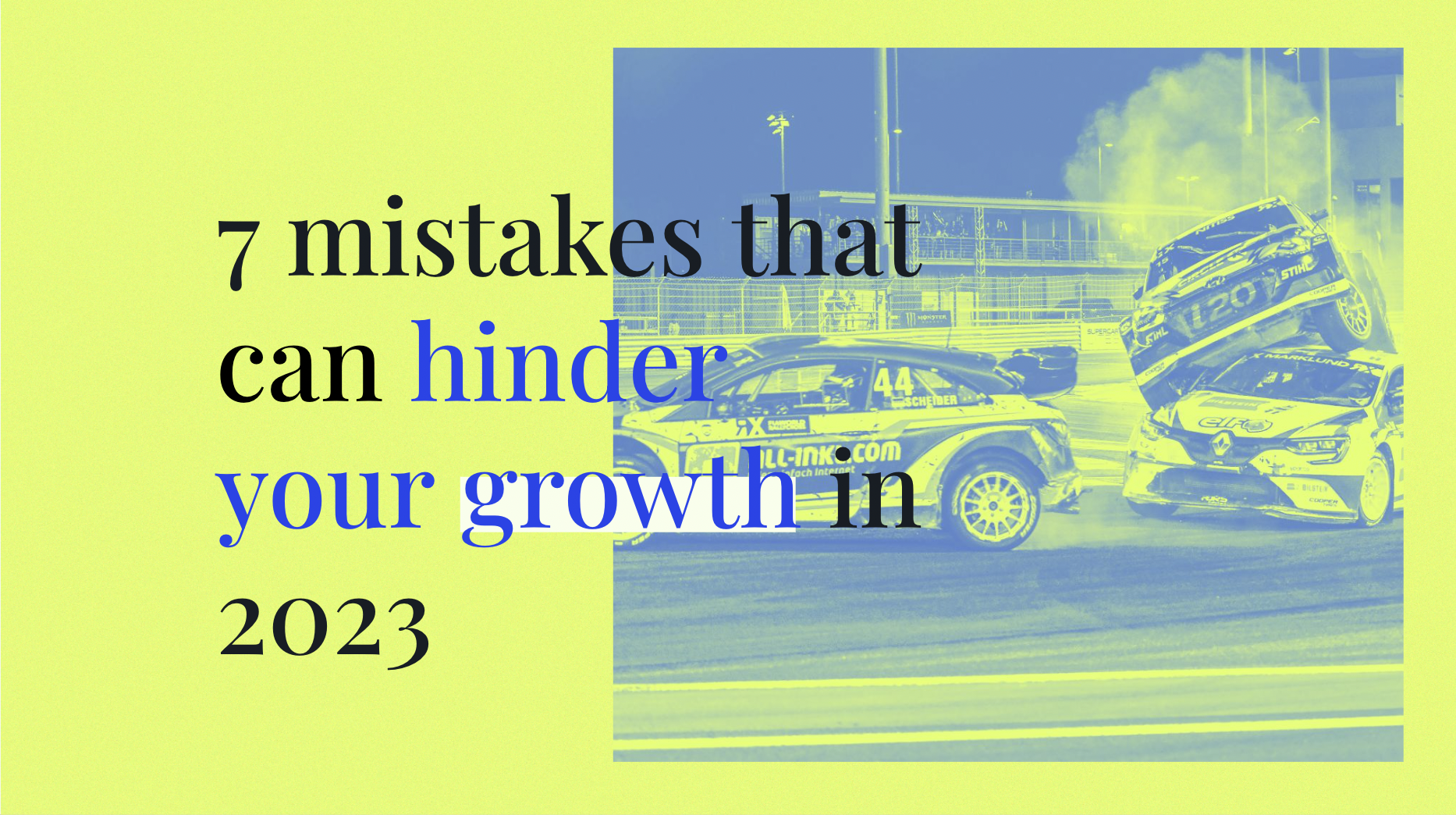
2023 is here, and with all the talk around recession, layoffs, and budget cuts, it’s a good time to reflect on what we can do better and learn from past mistakes.
None of us marketers are perfect, we all have biases and fall into different traps. So I wanted to take this opportunity and walk you through some of the most common mistakes I see B2B marketers I interact with make.
But before jumping into mistakes, I wanted to point out a paradox that I’ve noticed:
While it’s getting harder and harder to reach and convert your audience into buyers, it’s also more and more difficult for our buyers to purchase the right B2B services or products.
B2B communication has moved massively online (by 2025, Gartner estimates that 80% of buyer-vendor interactions will happen online), and buyers now use 10 or more channels to interact with vendors, according to McKinsey. And to top it all, organic visibility is on the decline.
So it’s a lot harder to reach your audience and stand out in a crowded space. You need more budget to do so, diverse marketing skills in your team, and more experienced people.
But the other side of the paradox is that while it’s harder to market, our buyers have a hard time making a purchase, too (in a Gartner survey, 77% of the respondents said that their latest purchase was complex or difficult).
With so many options available, it’s hard for buyers to decide which product will meet all their requirements and unique context.
But why is this happening? For me, this comes down to a misalignment between how buyers want to buy and how we’re trying to market and sell.
Many companies go to market with a short funnel that looks something like this:
Send traffic to a Gated asset → People who download the assets are enrolled in an automated email sequence → Send the contacts to sales
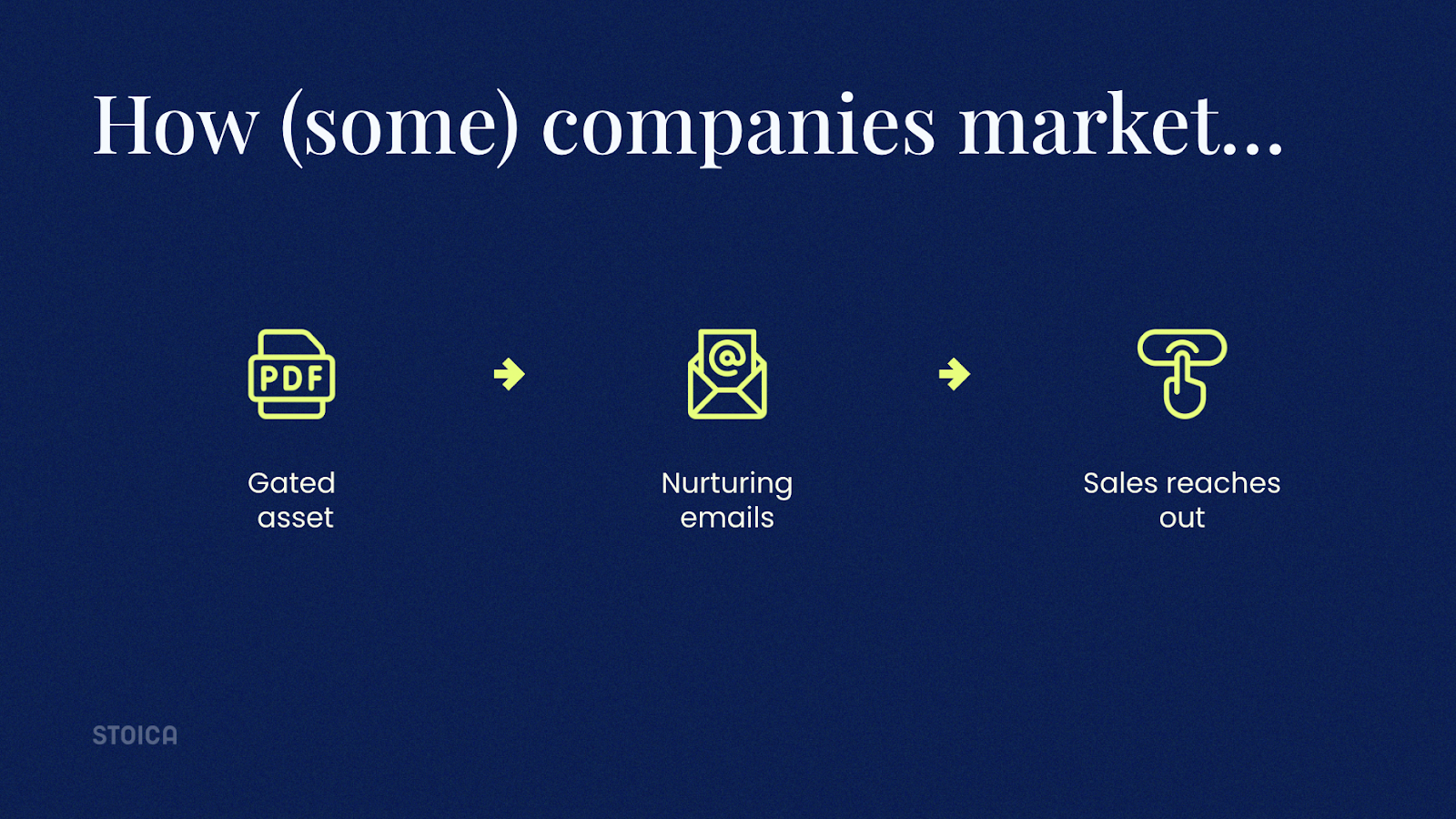
Or the more “sophisticated” version of the funnel:
You send traffic to your website via paid ads or people find your content on Google → visitors land on a blog article or campaign landing page → from there, you retarget them with an ad and present an offer → visitors convert to leads→ Marketing passes the contacts to sales
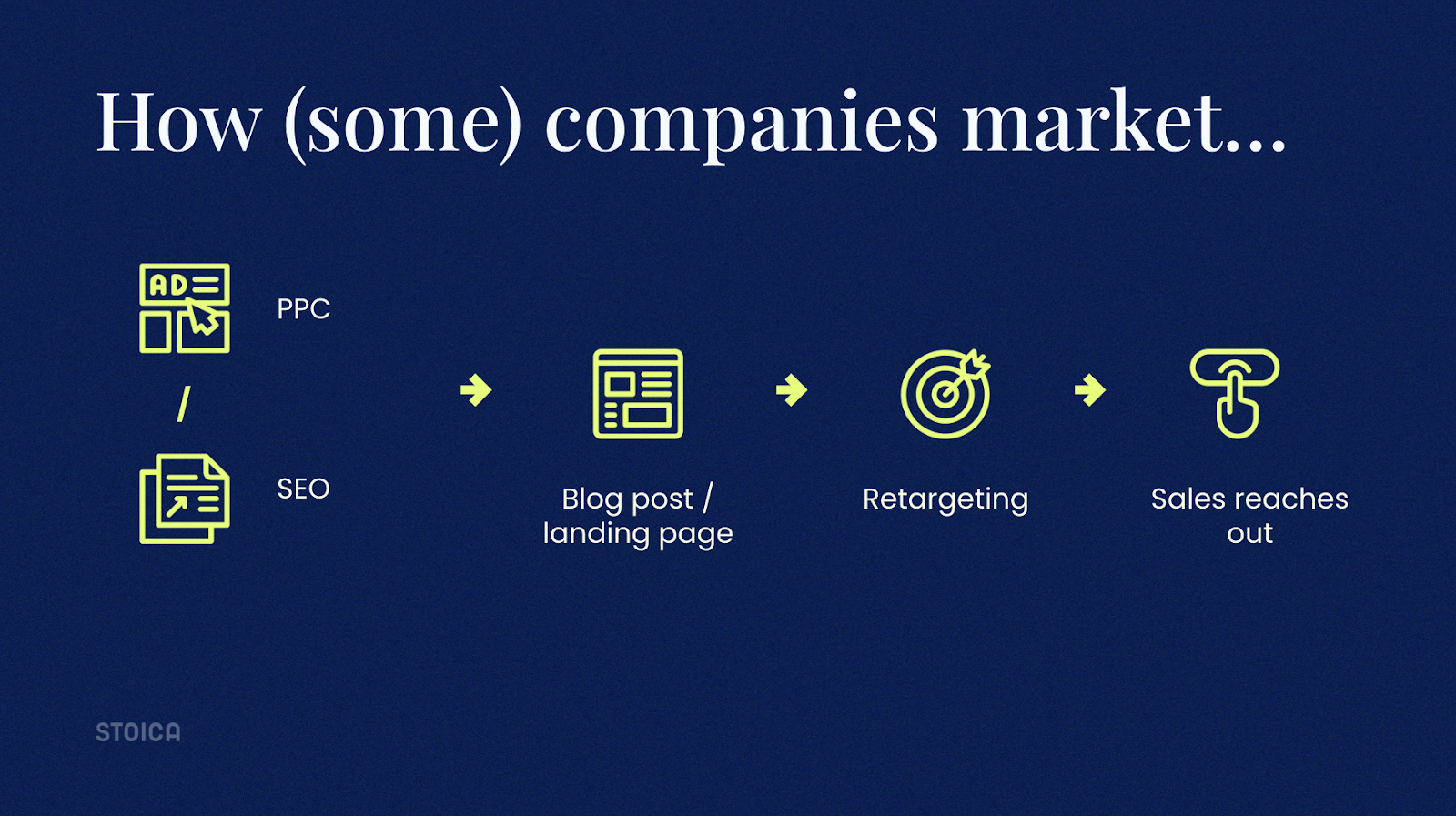
But these types of funnels have low conversion rates because it’s very possible that people either:
And that is 97% of your website traffic.
Instead, how people want to buy today looks so much different:
What does that tell you? If you’re marketing to people who are in the market today, you’re there too late to be able to earn their trust, educate them about your product and eventually tip the scale in your favor.
One statistic that caught my attention is a study done by Bain & Co that states:
“Buyers already have a list of potential vendors in mind before starting the search process, and 90% of the time they end up buying off that day 1 list.”
Bain & Co.
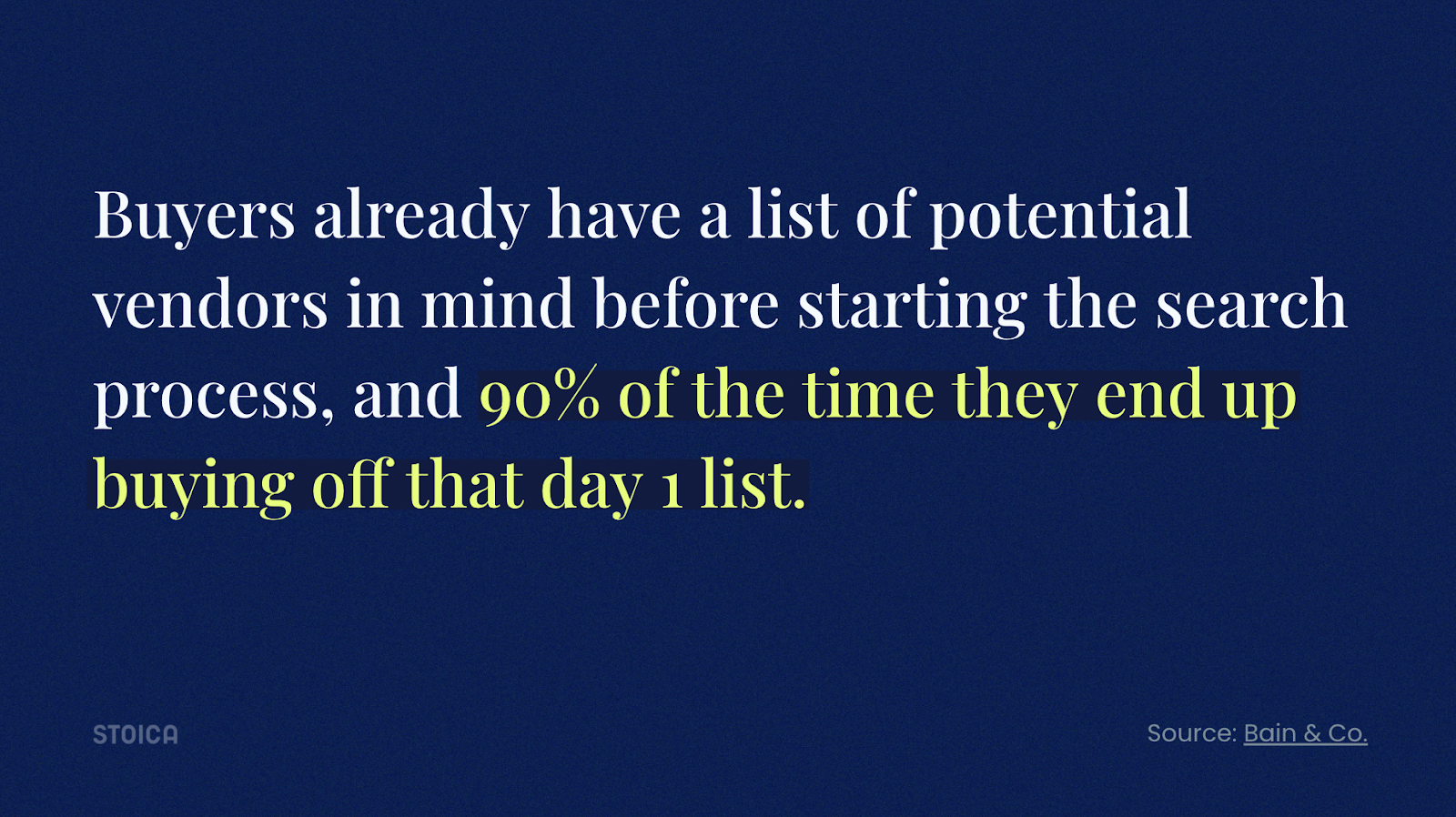
So my question for you is: How do you get into your buyers’ day one list?
Now let’s dive into the seven mistakes potentially hindering your marketing today.
While we talk about knowing our target audience, and who do we want to sell to, in reality, I see that very few marketing teams invest in customer research.
In some instances, they’ll say, “we sell to multiple industries, so we don’t have an ideal profile”.
Or suppose they spend time understanding and knowing their ideal client. In that case, they’ll focus too much on demographic data and too little on things that matter more: what triggers buyers to act, what problems they face, what alternatives they consider, and what objections and fears they face in the process.
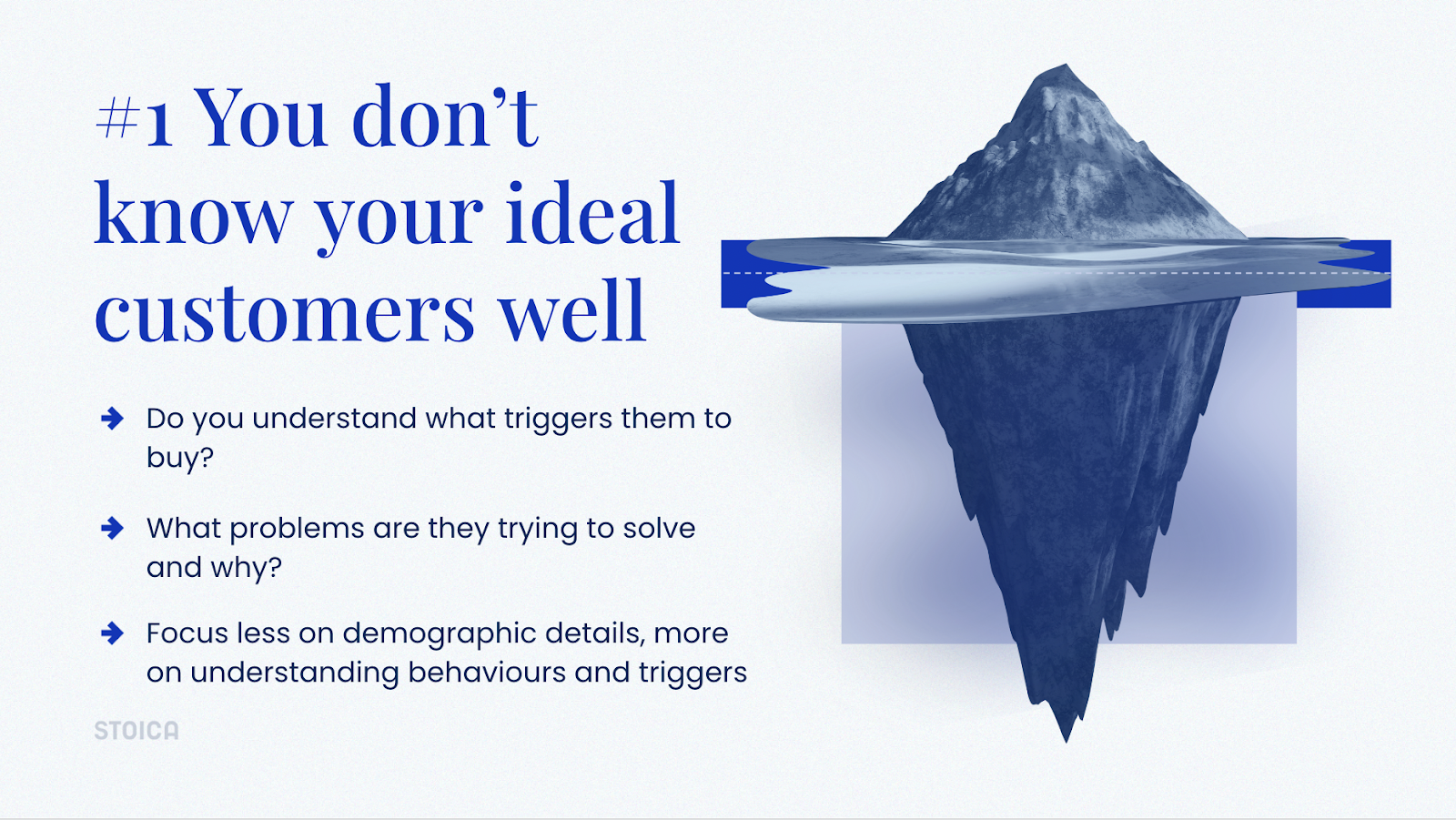
And I think this happens because marketing teams don’t have direct access to the client, so they go and do online research, look into their CRM, listen to sales calls – they’ll do anything except for talking to clients themselves.
And the reality is that if you don’t understand how people buy, you won’t be able to influence their buying journey.
Another trap I see is thinking marketing should produce measurable results every time. Every action should have an immediate impact – and that sort of transactional expectation is simply unrealistic.
Things like quality content, building a community around your brand, and building thought leadership content: all take time and I’ve seen marketers kill initiatives too soon just because those didn’t bring wins fast enough.
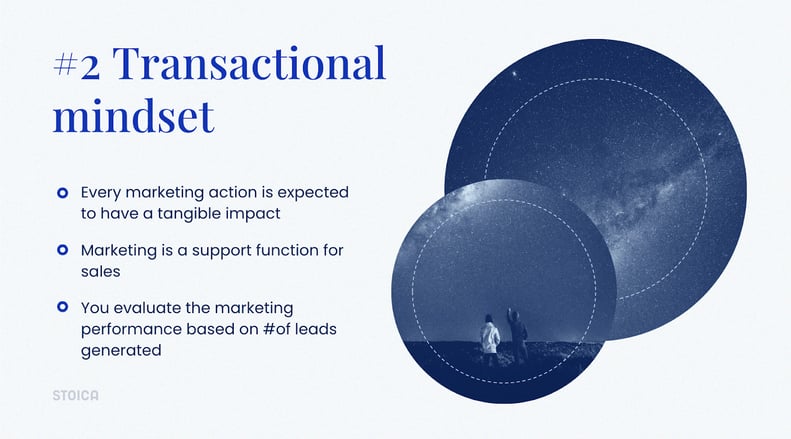
In many companies, especially the ones that have grown through sales, marketing still is at the service of sales, in charge of creating sale enablement materials and generating leads. And in that setup, marketing’s performance is evaluated by the number of leads they produce.
This is plain wrong: when the goal is to produce leads, marketing teams will be inclined to adopt a short-term mindset of bringing in new contacts, without considering the quality of those contacts and if they’ll ever convert to clients. If marketing’s job is to deliver a big volume of leads, that’s what marketing will do.
If you’re a LinkedIn lurker like I am, you’ve probably read a good share of content debating how lead generation is outdated, and demand generation is the “new thing” and why we all need to abandon the first.
My take? I think poor lead generation tactics are dead (gating low-quality pieces of content, sending leads directly to sales with no qualification and nurturing). However, lead gen done right is still relevant (helpful content, tools, and templates that solve a buyer’s problem, qualifying leads and following up based on triggers and their behavior).
It’s not an either/or game, you need both demand and lead generation.
You need to make buyers aware of your brand and solutions, and how you could solve their problems and pains, even before buyers are fully aware they need to solve those problems. But you also need to engage with buyers in a relevant way, build a relationship and be ready to start a sales conversation when they signal intent.
This leads me to mistake number 4: not nurturing based on intent (or not nurturing at all).
When leads enter your CRM, you need to have some sort of qualification process in place:
If you communicate the same way with all contacts, your messages won’t resonate with anyone – and it will be hard to spot who’s a hand raiser and who’s just there to collect information.
I believe the key is to define the different stages in your funnel, figure out what info people need to know at each stage, communicate in a personalized manner and use automation tools to qualify them in real-time.
Chasing short-term wins, we sometimes tend to focus too much on targeting keywords with a high volume of traffic, hoping to catch more website traffic.
The caveat with this approach is that high-volume keywords are super competitive, and so it’s hard to rank for, and most of the time, the intent is broad (so you might end up attracting the wrong kind of visits).
What I think is the healthy approach instead is to rethink your content plan to include content that:
→ addresses your buyers’ concerns and objections
→ addresses their misconceptions about your product/services
→ common questions they ask
Also, add to the mix your views about your industry, how you do things in your company and why, and key insights you acquired from working with a specific industry. I find most leaders have this knowledge but don’t focus on communicating about it (the trap of thinking everyone else has the same insights as you).
This type of content won’t come up when doing keyword research and most likely won’t bring massive traffic – but it will bring the right type of buyers.
I also think it’s not realistic to wait for Google to pick up this content on its radar – so distribute it across LinkedIn or other relevant social channels and dedicated communities you are in, with the intent of sharing valuable info (not just throwing links around).
When marketing has to prove ROI for every action they took, it’s tempting to chase vanity metrics that are not a real indicator of progress.
Metrics such as website traffic alone, number of social media followers, number of likes, shares, and comments.
What vanity metrics do is take the focus away from the real goal of generating revenue and moving the focus to chasing a ton of marketing metrics that don’t tell the whole story.
My personal belief is that marketing teams are better off when they choose fewer metrics to focus on, metrics that are tied to revenue generation and progress:
→ number of inbound leads
→ close rate (from inbound leads to MQL, SQL and clients)
→ time to close (contacts to clients)
→ CAC (customer acquisition cost)
→ % of revenue originating from marketing
This is an easy trap to fall into, and marketing experts and leaders I talk to cite inconsistency as being on top of their challenges.
When you take a spray-and-pray mentality, you target a broad audience hoping to capture more demand, you stretch your resources to cover more channels than you possibly can, or you test out more tactics than you have the capacity.
I feel that the pressure to produce quick wins is a big driver behind the spray-and-pray approach.
So I would advise you to evaluate your marketing plan every quarter and try to be as realistic as possible with your plans: do you have enough resources (in-house team, freelancer or agencies, budget, skills) to implement all the tactics in your plan?
I think it pays off to remember that a good strategy is about the things you won’t do just as much as it is about the thing you will do.
So how do we reach our ideal buyers in a more effective way and make it into their Day 1 vendor list?
We do in-depth customer research and work to understand how and why they buy. We make a realistic plan that takes into account the resources we have available. We use a mix of long-term (paid advertising, lead gen etc) and short-term tactics (community building, content, branding) and choose the right metrics to track progress.
And put in the right tools and processes to support our marketing activities (how we’ll do lead scoring, lead nurturing, sales handover etc).
All while being conscious of the fact that there is no perfect plan, nor can we do it all, but rather trying to focus on the tactics with the most impact, given our unique context.
How confident are you in your 2023 marketing planning?
If you need help building a coherent and clear marketing plan, we’re offering a free 30 minutes strategy call to explore your challenges and point you in the right direction.